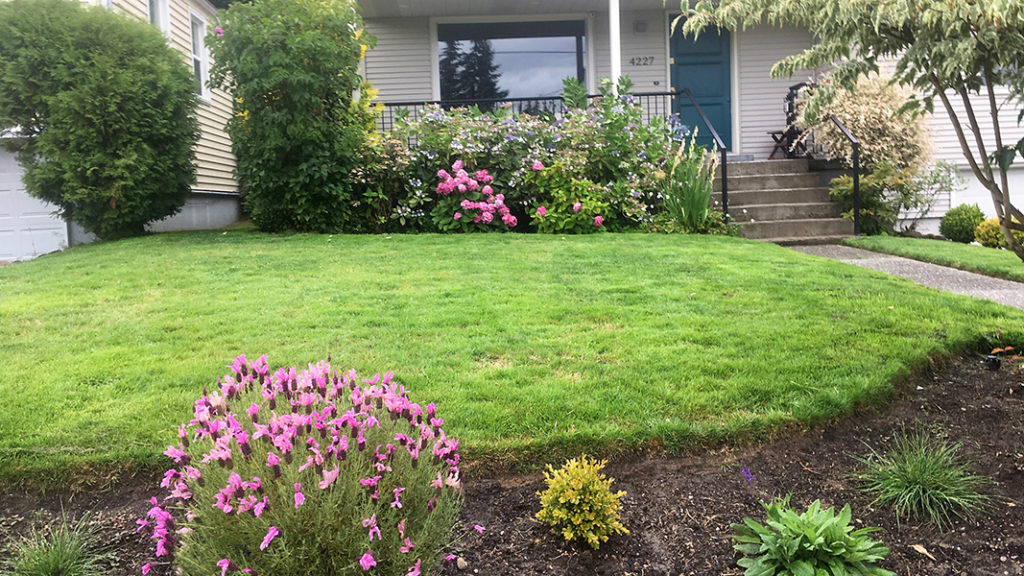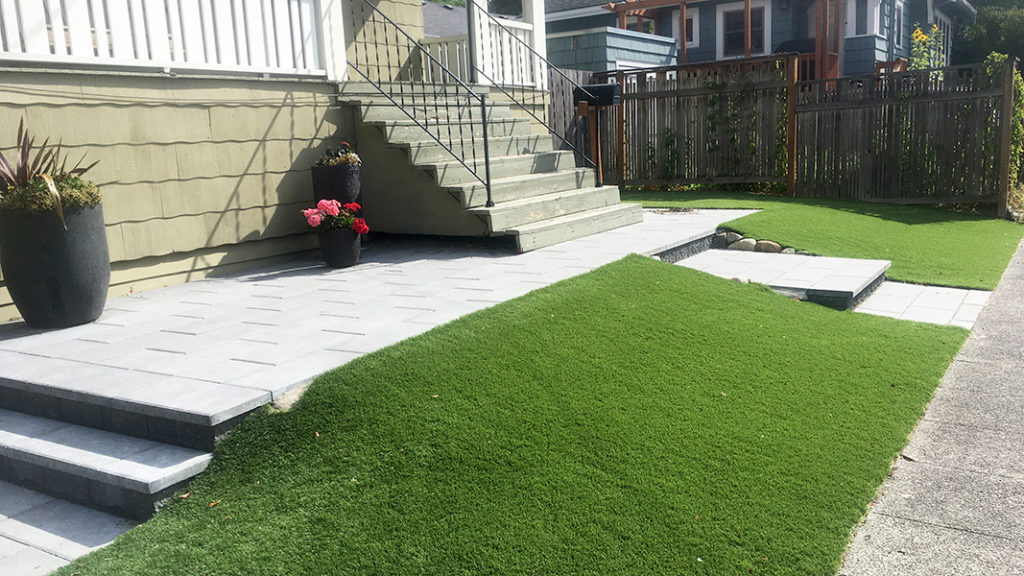 Sally Brown
Sally Brown
When Project Drawdown talked about Grassland Protection, it showed a picture of giraffes grazing in the African savannas. Talking about American grasslands, the closest you’ll come to those giraffes are some plastic pink flamingos. Grasslands in the U.S. — here I am referring to the irrigated kind — are more commonly known as lawns. They cover 40 million acres or a little bit less than Washington state (45.6 million acres). They account for about 2% of our total land area and cover a little less than half of all urban areas. Lawns are the largest irrigated crop in the country, taking up about three times the acreage of irrigated corn (Melesi et al., 2005).

Despite lawns being resource intensive (fertilizer and water), they are generally carbon sinks. Using compost can keep grass green and increase the carbon benefits. Photos courtesy of Sally Brown
We typically think of lawns as environmental disasters. Keeping the grass lush and green takes a lot of water and a lot of food. How much water these lawns need depends on where they are and how fastidious their stewards are. In some areas, rainfall is enough, even for those who want their grass to grow and grow. In other areas — those where you likely shouldn’t have lawns in the first place — you’ll need to add about 80 inches (200 cm) of water a year to keep that grass green. Considering watering the grass across the country, one study estimated that it would require the equivalent of 700 to 900 liters of water per person per day (Melesi et al., 2005). In terms of food, nitrogen needs for grasses are estimated as ranging from 98 to 195 kg/ha/yr. Less is required if you don’t need that intense golf course green color. Even if you do want that intense green, you can save on fertilizer if you leave your clippings to decay in place.
Carbon Sinks
However, just like the grasslands with the giraffes in Drawdown, the ones with the flamingos can be an important carbon sink. These urban lawns also offer much appreciated ecosystem services in urban areas. Even with all of that watering and fertilizer, these irrigated grasslands are typically still a carbon sink. One estimate shows that these urban grasslands can accumulate up to 17 Tg C per year. All of that water and fertilizer really do make the grass grow. Just think of your lazy neighbor who neglects his or her mowing duties. Above ground biomass production in turf grass is similar to corn or tall grass prairies (Thompson and Kao-Kniffin, 2019). In natural systems, grassland soils fall under the NRCS classification of Mollisols. Mollisols are characterized by a deep dark ‘A’ horizon that is chock full of organic matter from the dense rooting system of grasses. They are typically the mineral soils with the highest innate fertility and highest amount of stored carbon. These are the same soils that the ‘sodbusters’ tore up to plant wheat, paving the way for the dustbowl.

Plastic grass (above) will always be green and never require weeding or mowing. However, the carbon benefits of this turf are minimal at best.
Now it would seem across the U.S. we are creating new little patches of Mollisols, right next to driveways and just past the back porch. One study out of Baltimore found that the soils under the lawns stored more carbon and nitrogen than corresponding forest soils (Raciti et al, 2011). The authors dug down to 1 meter and focused on soils from relatively newly established lawns (3-60 years). The lawns stored almost 7 kg C per m2 while the forests stored 5.5. Granted, including the above ground trees in the forest would likely change that balance. But the point here is that grass isn’t all bad. And maybe more than not all bad, as some studies suggest that given how we take care of our lawns, they are the fastest soil carbon storage game in town and out.
Happy And Healthy Microbes
More recent studies have also started to investigate what the lawns provide in addition to being nice places to picnic and having high rates of carbon storage. A recent review looked at what is known about the microbial community living under the grass and what it does. Turns out that these bugs are busy. Urban grasslands are responsible for a range of ecosystem services including storm water and pollution mitigation, soil erosion control, and soil formation. By increasing soil carbon sequestration and nutrient retention, these bugs are also tasked with managing soil organic matter. Cutting the grass makes the roots give out more carbon which in turn keeps the bugs growing and busy. It also helps the bugs absorb more of the nitrogen in these systems.
Adding that cut grass to the surface also stimulates the bugs to eat up the leftovers with more than 30% gone within a week. However, none of this activity depleted the soil organic matter. The two combined work to make the soils under the grass a carbon sink for up to 20 to 40 years after the grass is established. For a soil microbe, a well-tended lawn is like a four star hotel. All you can eat and drink and all of high quality — regular microbial equivalents of prime rib (root exudates associated with mowing). One review noted that these conditions have selected “for copiotrophic microorganisms adapted to higher resource availability” — the soil equivalent of elite frequent flyers.
Maximizing Benefits With …. Compost!
All sounds pretty promising, right? These high-flying systems come at a cost: water, food and energy. Using optimal amounts of water, fertilizing in excess and mowing for that perfect look all take away from the benefits associated with urban grasslands. So how do we keep the grass green and maximize the benefits? You guessed it: use compost instead of traditional fertilizer. Remember that installment of the Drawdown series that talked about irrigation efficiency? The same way that compost increases water infiltration rates and water holding capacity in agriculture also works on your lawn. Remember that installment in the Drawdown series that talked about nutrients for agriculture? Those same nutrients also help your grass grow. Finally, that installment on regenerative agriculture and soil carbon storage. You get the picture; so does the literature.
There have been many papers over the years looking at the ability of composts and biosolids-based soil products to grow grass. Go into the Way Back time machine for this early article by Tester, 1989. The author added biosolids compost at different rates to Kentucky fescue in greenhouse and field studies. That grass grew and grew. Cecil Tester worked at the U.S. Department of Agriculture’s Beltsville lab while I was there for graduate school. He clearly loved his turf and relished first-hand knowledge of his chosen topic, especially on the golf course.
Two recent papers echo what Cecil found all of those years back. Evanylo et al (2016) tested a high and low rate application of compost (made from pulp sludge) and also looked at surface application and incorporation with the goal of growing grass on a newly disturbed soil. The higher rate of compost and the incorporated lower rate were the best for yield and that lovely green color. Soil bulk density was also reduced. The plots with those treatments got better with time. Stacey et al. (2019) tested the microbial community and grass response for golf course grass (Tester lives on) fertilized with composted biosolids. No change in the microbial community but the grass with the biosolids had higher nitrogen.
Just like in agricultural, forest or highway soils, compost and biosolids help keep soil healthy and plants happy. There are a few special points here about these irrigated grasslands. In many cases, our lawns are a lot closer to composting facilities and wastewater treatment plants than farms are. They offer a local customer base that is one and the same as the people who generate the feedstocks. That means that using compost products for lawns will also provide education and ownership for the people who you want to pay attention to what they toss and what they flush. Finally, these lawns come at an environmental cost but they do offer a range of environmental benefits. Using composts can cut that environmental cost completely for fertilizer and reduce it significantly for irrigation. It can also enhance the benefits for carbon storage. Compost does such a good job at keeping soil and nutrients in place that it is even required for new construction in the Seattle area. The Soils for Salmon program is a great place to learn more about the benefits of compost for lawns and gardens.
 One final note. A perfectly coiffed lawn is not to everyone’s taste. It is also not necessarily the best option when rainfall and water are prized commodities. You can reap even more benefits from your garden space by planting things other than turf grass. Get creative, experiment with different grasses that you don’t have to mow. Try natives. The more complicated your yard, the better the habitat.
One final note. A perfectly coiffed lawn is not to everyone’s taste. It is also not necessarily the best option when rainfall and water are prized commodities. You can reap even more benefits from your garden space by planting things other than turf grass. Get creative, experiment with different grasses that you don’t have to mow. Try natives. The more complicated your yard, the better the habitat.
P.S. I was on our local TV station talking about real grass versus the plastic kind recently. Watch Sally live!
Sally Brown, BioCycle’s Senior Adviser, is a Research Professor at the University of Washington in the College of the Environment.













